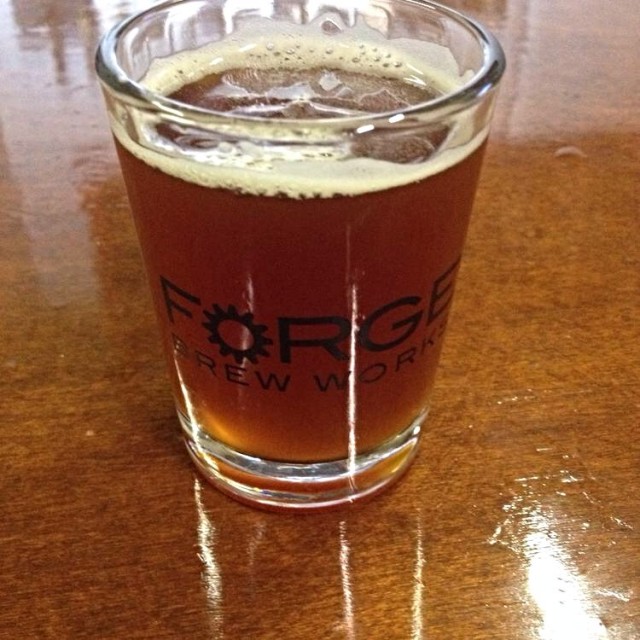 |
| Beautiful, isn't it? |
It’s
been a while since my last post on style, so I think it’s high time I broke
another one down for you. And since February is in the home stretch, and March
is generally associated with Ireland, it’s only fitting that I discuss one of
the styles usually allied with March and Ireland – the red ale.
For
most, the term “red ale” immediately stirs towards George Killian’s Irish Red
Ale, which is actually an amber lager by style, and ever since selling out to
Pete Coors, has significantly spiraled down a path towards “not good.” Simply
put, the style “red ale” is a catch-all for any beer that is lighter in color
than a dark ale, ranging from amber to deep red hues. The flavor and aroma tend
to focus on malt character as opposed to hop character, however it is not
unheard of for a “red ale” to be significantly hoppy. “Red ales” are typically
well-balanced with toasted malt features and light fruitiness notes.
In other
words, “red ale” is a fringe style that has very little in the way of
guidelines, meaning that it has endless possibilities for brewers, and in turn,
endless possibilities for drinkers. Even the highly touted Great American Beer
Festival (think the Oscar Awards for beer) doesn't have a specific style for “red
ales,” fitting them neatly into the wide-ranging “American amber/red ale”
category. It’s another clear example of definition by elimination, but like I
said… endless possibilities.
So let’s
look at a few. As I intimated in the opening verse, “red ales” are
traditionally linked to Ireland, and are often called an “Irish Red Ale.” Unfortunately,
there’s not a whole lot to say with the history of “Irish Red Ale.” It
originated in the town of Kilnenny, in 1710, and was pretty similar to an
English Pale Ale, the only difference being a bit of roasted barley added to
the grist. This gave the beer a darker, red color and added a toasty, dry
flavor, making it very smooth and highly drinkable. A very good example of an
Irish red ale is Smithwicks.
 |
| Kilkenny Castle, Republic of Ireland |
Interestingly,
it’s not a style that has a huge following in its native homeland, being dwarfed
by other Irish styles like dry stout and lager. “Red ales” are much more
popular here in the U.S. due to the relentless marketing of Killian’s (which is
actually an Amber Lager, and a shell of what it used to taste like). Back when
Killian’s rose in prominence, red beers were all the rage in America, and all
of them were actually Amber Lagers and did not fall under the category of what
true Irish Red Ale is supposed to taste like.
 |
| True to style - pretty good |
Of
course, like it always does, the craft-brewing community came to the rescue,
and began brewing proper (and accurate) Irish red ales. Beers like Harpoon
Brewery’s Celtic Ale from Boston and Great Lakes Brewing Company’s Conway’s
Irish Ale from Cleveland are perfect examples of what I’m talking about. In
fact, recently, I got a hold of a bomber of Fred Red by the Blue & Gray
Brewery from Fredericksburg, VA that also exemplified a perfect representation
of what an “Irish red ale” is supposed to be. Fred Red had a robust malty base balanced
with selective European hops for a fresh, bold finish. Nothing over the top,
just a quality, well put together, Irish-style red ale.
 |
| In a word, scrumtrulescent |
But as I
also said earlier (I love referencing myself when making a point), American red
ale is all over the place in its non-definition, creating all of those lovely
little possibilities and opportunities I mentioned. Out on the left coast,
beers like Port Brewing’s Shark Attack Double Red Ale from San Diego, Speakeasy
Brewing’s Prohibition Ale from San Francisco and Bear Republic’s Red Rocket Ale
from north of San Francisco are perfect examples of what American ingenuity brings
to a beer style. By way of example, yesterday, I got into a pint of Forge Brew
Works’ Martin’s Bane Imperial Red Ale from Lorton, VA. Martin’s Bane was
phenomenal – well balanced between malt and hops, while keeping enough
hoppiness around to satisfy the hop head. It was very smooth for an imperial,
hitting north of 8% ABV, and there was little to no alcohol heat. The beer
poured a gorgeous red-hued amber color with white head. Literally, everything
you want – nothing you don’t.
But
doubling up the malt and hops into imperial mode is only one variation on “red
ales” that the Americans are brewing up these days. I've also started seeing a
style that the folks are referring to as Red IPA surfacing and spreading like
wildfire. The Red IPA is essentially a red ale that is aggressively hopped like
an IPA. Sounds delicious, right? In this same spirit, a brewer could easily
play around with all of the aspects of the red ale and make new beers that are really
cool. For example, replace the yeast in the red with a Belgian yeast, and now you've got a Belgian Red Ale. Then, use that same yeast but add the hops from
your Red IPA, and now you've got a Belgian Red IPA. What if we added
Raspberries into the boil (or fermentation)? Now it’s a Red Framboise IPA. Endless
possibilities.
 |
| What kind of super plant is this? Raspberries and hops together? Madness! |
So if
you observe the Irish festivities in March, and you find yourself drinking
beer, look for a red ale, and try to find one that is actually a red ale. And
look for ones that are Irish (Smithwicks or O’Hara’s). And look for ones that offer
endless possibilities. That’s the American way.
Here’s
to craft-brewed happiness… Cheers!
No comments:
Post a Comment